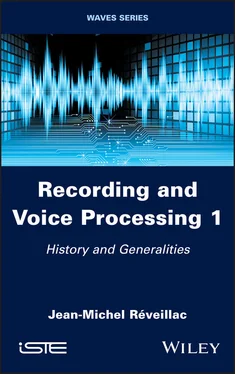1 Cover
2 Title Page
3 Copyright First published 2021 in Great Britain and the United States by ISTE Ltd and John Wiley & Sons, Inc. Apart from any fair dealing for the purposes of research or private study, or criticism or review, as permitted under the Copyright, Designs and Patents Act 1988, this publication may only be reproduced, stored or transmitted, in any form or by any means, with the prior permission in writing of the publishers, or in the case of reprographic reproduction in accordance with the terms and licenses issued by the CLA. Enquiries concerning reproduction outside these terms should be sent to the publishers at the undermentioned address: ISTE Ltd 27-37 St George’s Road London SW19 4EU UK www.iste.co.uk John Wiley & Sons, Inc. 111 River Street Hoboken, NJ 07030 USA www.wiley.com © ISTE Ltd 2021 The rights of Jean-Michel Réveillac to be identified as the author of this work have been asserted by him in accordance with the Copyright, Designs and Patents Act 1988. Library of Congress Control Number: 2021942968 British Library Cataloguing-in-Publication Data A CIP record for this book is available from the British Library ISBN 978-1-78630-670-8
4 Preface
5 Introduction
6 1 Recording History
1.1. In the beginning was the phonautograph
1.2. When it really started
1.3. Magnetic recording
1.4. The advent of 78 rpm
1.5. The magnetic tape and the LP
1.6. 8-track cartridges, mini-cassette and Trimicron
1.7. The compact disk and the advent of digital technology
1.8. Digital technology is essential
1.9. Hard disk recorder and minidisc
1.10. Microcomputer, direct-to-disk and DAW
1.11. To conclude
7 2 The Voice
2.1. The vocal apparatus and its functioning
2.2. Voice and breath
2.3. Song and speech
2.4. Frequency, intensity and timbre
2.5. Voice and range
2.6. Voice quality
2.7. Characteristics of the vocal timbre
2.8. Conclusion
8 3 Microphones
3.1. A little history
3.2. The characteristics of a microphone
3.3. Microphone families
3.4. Uses of microphones according to their directivity
3.5. Conclusion
9 4 The Acoustic Environment
4.1. Location of pickup and sound isolation
4.2 Acoustic processing
4.3. Acoustic booths
4.4. Accessories
4.5. Conclusion
10 Conclusion
11 Appendices
12 Appendix 1. Sound Unit
13 Appendix 2. Audio Connectivity
14 Appendix 3. Audio Processing Plugins
15 Appendix 4. Tube and JFET Microphone Amplifiers
16 Appendix 5. Microphone Pairs
17 Glossary
18 References
19 Index
1 Introduction Figure I.1. Vocal differences in the same sentence. 3D spectrogram of a male voi... Figure I.2. A wire recorder, the Webster Chicago 180-1 (1949). For a color versi... Figure I.3. The famous Neumann U67 tube microphone and its power supply. For a c... Figure I.4. The famous EMI Abbey Road studio 2 control room with its REDD.37 con...
2 Chapter 1 Figure 1.1. The phonautograph. For a color version of this figure, see www.iste.... Figure 1.2. Charles Cros’ “paleophone” Figure 1.3. Edison’s phonograph Figure 1.4. A Pathé sapphire pick-up for a vertically engraved disk. For a color... Figure 1.5. Emile Berliner and his first phonograph Figure 1.6. The Columbia Graphophone Grand. For a color version of this figure, ... Figure 1.7. The “Edison Concert” phonograph. For a color version of this figure,... Figure 1.8. Poulsen’s “telegraphone” Figure 1.9. The Columbia Multiplex, with its three pavilions Figure 1.10. Pathé’s “Poisson” Pantograph. At the left end is the engraving styl... Figure 1.11. Pathé’s “Poisson” principle Figure 1.12. A Columbia double-sided 78 with its cover. For a color version of t... Figure 1.13. The electric pick-up (top) and the membrane read head (bottom) Figure 1.14. Examples of electric pick-up phono cabinets (wireless telegraphy). ... Figure 1.15. A mechanical phonograph case. For a color version of this figure, s... Figure 1.16. Curt Stille’s magnetic reader-recorder Figure 1.17. Fritz Pfleumer with his magnetic tape machine Figure 1.18. The AEG K1 tape recorder (the letter K stands for “Koffer”, the sui... Figure 1.19. A 4 (rpm) disk and its cover. For a color version of this figure, s... Figure 1.20. An electrophone from the 1950s. For a color version of this figure,... Figure 1.21. Pick-up and groove of a stereophonic LP Figure 1.22. The Nagra I news reel-to-reel tape recorder with miniature lamps. F... Figure 1.23. An 8-track tape and its internal structure. For a color version of ... Figure 1.24. The Akai GXR-82D 8-track tape player/recorder Figure 1.25. A limited edition 8-track released in 2009 – Cheap Trick – “The Lat... Figure 1.26. The Telefunken 76 (Tube) tape recorder, 4 tracks (stereo 2 X 2 trac... Figure 1.27. The different formats of magnetic tape recording Figure 1.28. One of the first mini-cassette player-recorders with its microphone... Figure 1.29. A type I – C90 (2 X 45 min) mini-cassette from TDK. For a color ver... Figure 1.30. The Tascam 122 MKII professional cassette deck. For a color version... Figure 1.31. The Portastudio 144 stand-alone multitrack from Tascam (1979). For ... Figure 1.32. A musicassette – Metallica – “Master of Puppets”. For a color versi...Figure 1.33. A trimicron disk from MDR. For a color version of this figure, see ...Figure 1.34. A 24-track 2-inch multitrack (Studer A800 – MKII), a standard of ex...Figure 1.35. The first CD released by Sony, Billy Joel – “52nd Street”. It came ...Figure 1.36. The first two commercial CD players, the Philips CD100 (left) and t...Figure 1.37. The first portable CD Player, Sony D50 “Discman”Figure 1.38. Studer D827 Mk II (DASH 48 tracks) with its remote control console....Figure 1.39. Sony PCM 3324 S digital multitrack (DASH 24 Tracks). For a color ve...Figure 1.40. A studio DAT player-recorder – Sony PCM 2800Figure 1.41. A DAT cassette (73 x 54 10.5 mm), on the left, compared to a mini-c...Figure 1.42. A DCC cassetteFigure 1.43. The Matsushita RS-DC8 technics DCC player-recorderFigure 1.44. The first-generation ADAT Blackface player from Alesis. For a color...Figure 1.45. An S-VHS tape for use with an ADAT recorder. For a color version of...Figure 1.46. The Tascam DA-88 digital player-recorder. For a color version of th...Figure 1.47. A 90 minute Hi-8 cassette (95 x 62 x 15 mm). For a color version of...Figure 1.48. The imposing Akai DR1200 reader-recorder with its bank of vu-meters...Figure 1.49. The Fostex D80 hard disk recorder – 8 tracks (1996). For a color ve...Figure 1.50. Tascam MX-2424 – 24-bit, 96 kHz, 24-track hard disk recorder (2004)...Figure 1.51. A minidisc. For a color version of this figure, see www.iste.co.uk/...Figure 1.52. The Tascam MD-801R MKII minidisc player-recorder. For a color versi...Figure 1.53. Digidesign sound designer (left) and sound tools (right)Figure 1.54. The Audiomedia II board in Nubus format for Apple Macintosh. For a ...Figure 1.55. The 888 interface for Pro Tools III. For a color version of this fi...Figure 1.56. Pro Tools 2020 version. For a color version of this figure, see www...Figure 1.57. Evolution of the vinyl record market worldwideFigure 1.58. The T560 vinyl engraving bench of the German manufacturer Souri’s A...
3 Chapter 2Figure 2.1. The stages of sound creation in a human beingFigure 2.2. The different elements of the phonation chainFigure 2.3. Larynx and vocal cords, the key elements of the voice’s timbreFigure 2.4. Thoracic cage, sternum and intercostal muscleFigure 2.5. The oblique and transverse abdominal musclesFigure 2.6. The soprano rangeFigure 2.7. The mezzo-soprano rangeFigure 2.8. The alto rangeFigure 2.9. The tenor rangeFigure 2.10. The baritone rangeFigure 2.11. The bass rangeFigure 2.12. Concept of voice quality 1
Читать дальше












